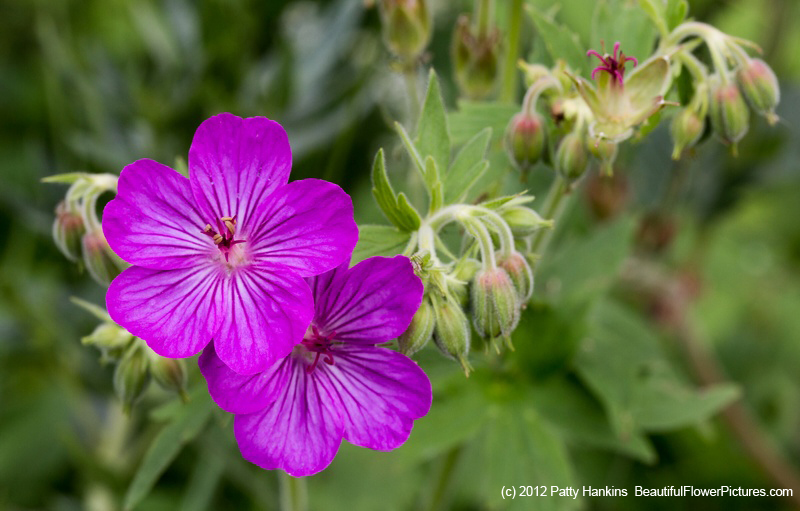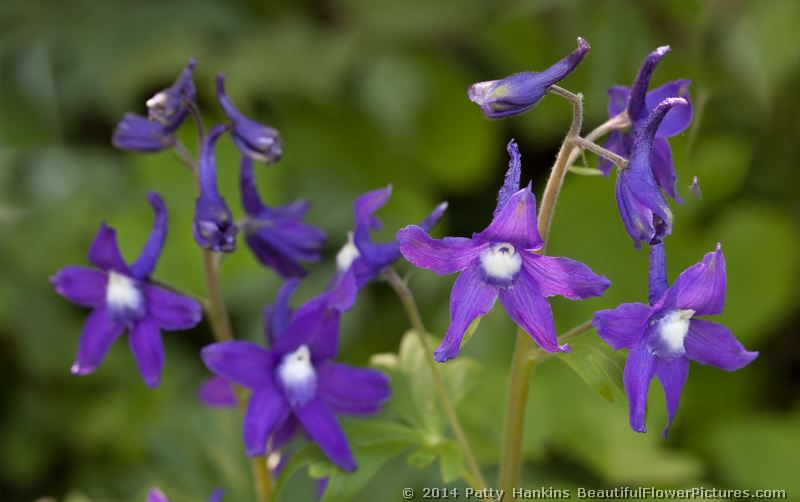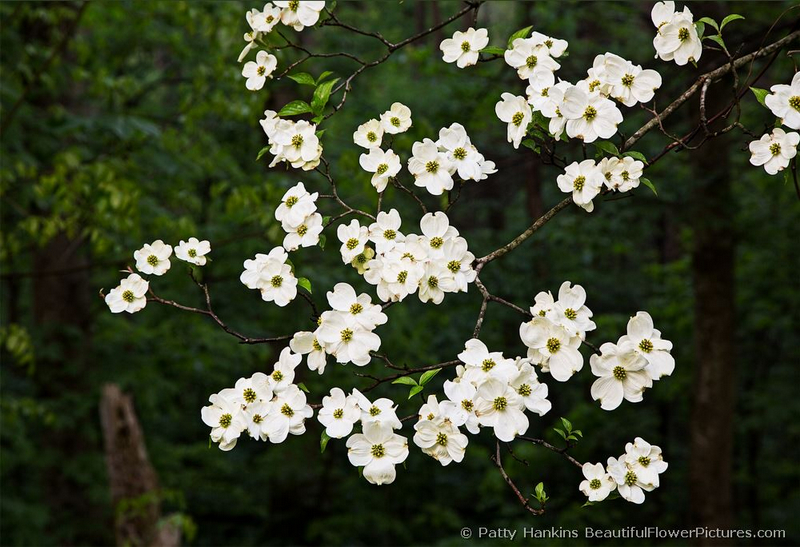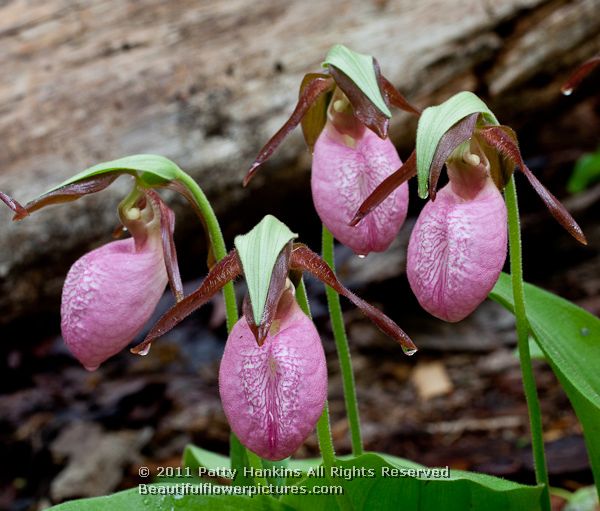
by hankinslawrenceimages | Oct 31, 2014 | 2015 Wildflower Calendar, Flowers, Liliaceae Family, Wildflowers

White Trout Lily © 2012 Patty Hankins
I’ve photographed the White Trout Lilies (Erythronium albidum) at Turkey Run Park in Virginia a few times now. They bloom in the early spring (at the same time as the yellow trout lilies) in the Washington, DC area. On the right day at Turkey Run Park, it’s not uncommon to see close to 100 yellow trout lilies – but only 3 or 4 white ones. So I was thrilled to find this one particular white trout lily among a sea of green, just waiting to be photographed in the afternoon light.
Like the yellow trout lilies, White Trout Lilies play an important role in the forest community. The leaves capture and store phosphorus in early spring, which is then returned to the soil as the leaves die during the year. The early-blooming flowers provide pollen and nectar for queen-bees and serve as an energy supply for emerging worker bees. Bee larvae feed on the pollen – and then go on to pollinate other plants such as clover and alfalfa.
White Trout Lily is one of the wildflowers featured in my 2015 Wildflower Calendar. You can order your copy from my website.

by hankinslawrenceimages | Oct 24, 2014 | 2015 Wildflower Calendar, Flowers, Gentianaceae Family, Wildflowers

Sticky Geranium © 2012 Patty Hankins
Sticky Geranium – Geranium viscosissimum – is one of the wonderful wildflowers I discovered at Glacier National Park a few years ago. When I spotted it growing along the side of the road, I know it had to be a member of the geranium family since it looks so much like the wild geraniums I see in the Smoky Mountains in the spring.
Sticky Geranium is native to much of the Western United States and Canada. A summer blooming wildflower, sticky geranium can grow to 3 feet tall. The stalks of the plant have multiple pink to purple flowers blooming on them all summer long.
I loved seeing the sticky geranium in Glacier, Yellowstone and Grand Teton National Parks. The bright flowers were just wonderful to see as I drove along the roads and hiked the trails.
Sticky Geranium is one of the wildflowers featured in my 2015 Wildflower Calendar. You can order your copy from my website.

by hankinslawrenceimages | Oct 17, 2014 | 2015 Wildflower Calendar, Flowers, Liliaceae Family, Wildflowers

Yellow Trillium © 2014 Patty Hankins
What can I saw about yellow trillium – other than I know I’m in the Smokey Mountains in the spring when I start seeing yellow trillium (trillium luteum).
Yellow Trillium (trillium luteum) are one of the most easily identifiable spring wildflowers that bloom in the Smoky Mountains – once your realize what it is! I’d seen several varieties of the white, pink and red trilliums before I saw the yellow ones – and at first I didn’t recognize them as trillium. All the ones I’d seen before then had been pedicillate trilliums where the petals seem to open out from a central point. Yellow Trillium are sessile trilliums, where the petals seem to grow straight up from the stem.
Native to the Southeastern United States, Michigan and Ontario, Canada, yellow trillium bloom in the spring. They can grow to about 16 inches tall. The three mottled green leaves grow to 6 inches long. The three yellow petals start out as a green yellow aging to a deeper yellow. They grow basicly erect from the stem.
If you are in the right place, you can see big clusters of yellow trillium. And if you go back the next year, chances are – the patch of yellow trillium will be even bigger. 
Yellow Trillium is one of the wildflowers featured in my 2015 Wildflower Calendar. You can order your copy from my website.

by hankinslawrenceimages | Oct 10, 2014 | 2015 Wildflower Calendar, Flowers, Ranunculaceae Family

Dwarf Larkspur © 2014 Patty Hankins
Every now and then when I’m driving along in a National Park – I’ll see a splash of color out the corner of my eye – and know that I need to turn around and figure out what I just saw. If I’m alone – not a problem – I just look for the next pull-out – do a quick U-turn – and head back to photograph the flowers. Of course, when Bill is with me – I have to explain to him what I saw – and that yes – we really are turning around to figure out what it was – and that I’ll probably be photographing for the next 20 minutes or so. Over the years – Bill has gotten much better about me saying STOP!!!! and doing the turn and letting me photograph for a while.
The Dwarf Larkspur (Delphinium Tricorne) along the Blue Ridge Parkway in North Carolina is one of the flowers that has caused a number of sudden U-Turns over the years. I’ve only spotted dwarf larkspur in the wild in a few spots along the parkway – and I never remember exactly where they are. I know they’re somewhere within the first couple of hours of driving heading north from Cherokee – and that they are usually on the right side of the road. So in late April/early May – I know to keep my eye out for them – and if I’m lucky I’ll spot them along the side of the road. That’s what happened with this set – I just happened to catch a splash of purple among the green grass and there they were.
Dwarf Larkspur is one of the wildflowers featured in my 2015 Wildflower Calendar. You can order your copy from my website.

by hankinslawrenceimages | Oct 3, 2014 | 2015 Wildflower Calendar, Cornaceae Family, Flowers, Wildflowers

American Dogwood © 2013 Patty Hankins
One of my favorite scenes in the spring is seeing a beautiful white dogwood tree (cornus florida) in full bloom in the woods. There is just something incredible about seeing the crisp white blossoms against the greens and browns of the woods.
I spotted this dogwood tree along the side of the road one morning in the Great Smoky Mountains National Park. I was on my way up the mountain hoping to catch sunrise from Clingman’s Dome, so I didn’t stop on the way up. Sunrise was a bust that morning – totally overcast at the peak. The only way those of us waiting to photograph sunrise could be sure that the sun was up was by looking at our watches! There was a slight change in the sky color from dark gray to slightly less dark gray – and that was it.
So I headed back down the mountain feeling rather disappointed that I hadn’t managed to photograph sunrise. But then I remembered the dogwood tree I’d spotted on the way up. So I stopped, spent about half an hour photographing the dogwood tree against the woods in the distance. At one point, the sun barely broke through the clouds just brightening up the blossoms – which was when I captured this photo.
It was one of those mornings where I didn’t photograph what I hoped to – but still came away with wonderful memories of a beautiful scene in the Smoky Mountains and this photograph.
American Dogwood is one of the photographs featured in the my 2015 Wildflower Calendar. It is also available as a gallery wrapped canvas and as a matted photograph.

by hankinslawrenceimages | Sep 26, 2014 | 2015 Wildflower Calendar, Flowers, Orchidaceae Family, Wildflowers

Pink Lady’s Slipper © 2014 Patty Hankins
Ahh – the Pink Lady’s Slipper. So many people I’ve met over the years have shared such wonderful stories with me about how they used to go into the woods with their grandmothers to look for the Pink Lady’s Slippers each spring.
I’d only seen Pink Lady’s Slippers once or twice until I started spending time in the Great Smoky Mountains National Park each spring. Now I manage to find them almost every year. I’ve discovered a few trails where I can find up to 30 lady’s slippers in one small area. And you can be sure I go back and visit those spots every time I’m in Gatlinburg.
Varieties of pink lady’s slippers (cypripedium acaule) can be found throughout much of the eastern United States and Canada. They are considered endangered or threatened in Illinois, Tennessee, and New York. The biggest threats to the Pink Lady’s Slippers are loss of habitat and harvesting of wild plants for sale. Since the lady’s slippers require very specific growing conditions – harvested wild plants rarely survive when transplanted.
So I hope you’ll understand that I’m not going to share where exactly I found this set of lady’s slippers – but I will tell you they are wonderful to see in the wild and I can certainly understand why so many people treasure the memories of seeing them with family members over the years.
Pink Lady’s Slipper is one of the wildflowers featured in my 2015 Wildflower Calendar. My calendar features photographs of twelve different wildflowers I’ve taken in recent years.











